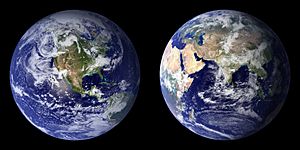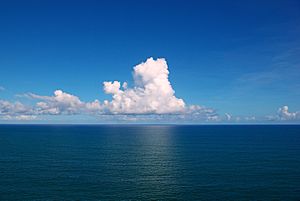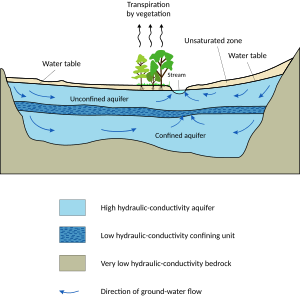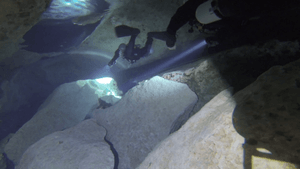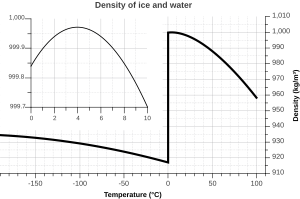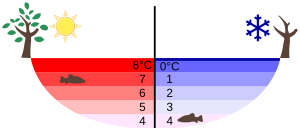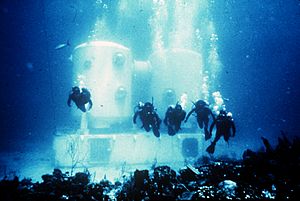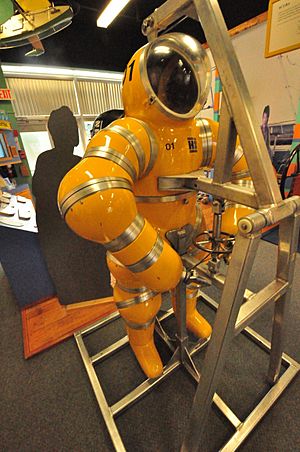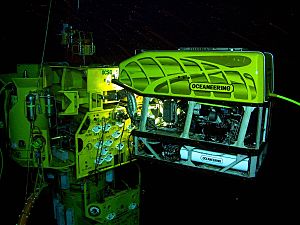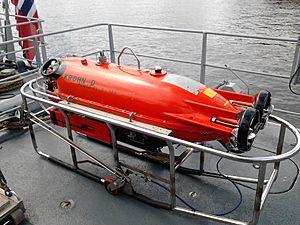Underwater environment facts for kids
An underwater environment is a place completely surrounded by liquid water. This can be in natural places like oceans, seas, lakes, ponds, and rivers. It can also be in human-made places like canals or reservoirs. Some things about underwater environments are always the same, but many depend on where they are.
Water has been on Earth for a very long time. Scientists think that life on Earth first started in the underwater environment. It's still a super important place for living things. Most living creatures on our planet call the water their home. Many different types of science study this amazing environment.
People do many activities in the parts of the underwater world they can reach. This includes scientific research and underwater diving for fun or work. It also includes using submarines for defense. The underwater world can be tough for humans. It's often hard to reach, so we haven't explored much of it yet.
Contents
How Big is the Underwater World?
About three-quarters of our planet Earth is covered by water. Most of the Earth's solid surface is deep under the oceans. These deep areas are called abyssal plains. They are usually between 4,000 and 5,500 meters (13,000 to 18,000 feet) deep. The deepest known spot on Earth is the Challenger Deep. It's in the Mariana Trench and is about 10,924 meters (35,840 feet) deep!
Besides oceans, there are also large areas covered by fresh water. A huge amount of water is also found underground in aquifers. Because the underwater world is so challenging for humans, we haven't explored much of it. We can map it using sonar, which uses sound waves. We can also explore it more closely using special vehicles. These include manned submersibles, or robots called remotely operated vehicles (ROVs) and autonomous underwater vehicles (AUVs).
Oceans and Seas
An ocean is a huge body of water that makes up most of a planet's water. On Earth, the main oceans are the Pacific, Atlantic, Indian, Southern (Antarctic), and Arctic Oceans. Sometimes, people use "ocean" and "sea" to mean the same thing. But usually, a sea is a part of the ocean that is partly or fully surrounded by land.
Salty water covers about 361 million square kilometers (139 million sq mi) of Earth. This is about 71% of Earth's surface. The ocean holds 97% of all Earth's water. Scientists who study oceans, called oceanographers, say that less than 5% of the World Ocean has been explored! The total amount of water in the oceans is about 1.35 billion cubic kilometers (320 million cu mi). The average depth is nearly 3,700 meters (12,100 feet).
Lakes, Ponds, and Rivers
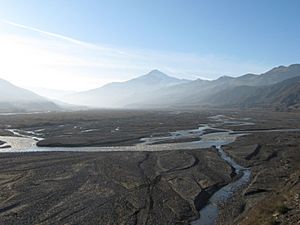
A lake is an area filled with water, surrounded by land. It's usually fed or drained by a river or other outlet. Lakes are on land and are not part of the ocean. They are also bigger and deeper than ponds. Most lakes get their water from rivers and streams. Natural lakes are often found in mountains or areas where glaciers once were.
Many lakes are human-made. People build them for things like farming, making electricity, or for fun activities.
A pond is a smaller area of water than a lake. It can be natural or human-made. Ponds often have shallow water with many plants and animals. People use ponds for farming, raising fish, or as part of beautiful landscapes. Ponds can have fresh, salty, or slightly salty water.
A river is a natural flowing watercourse, usually freshwater. It flows because of gravity, usually into an ocean, lake, or another river. Small rivers can be called streams, creeks, or brooks. Rivers are part of the water cycle. They collect water from rain, melting snow, and underground sources.
Subterranean Water
An aquifer is an underground layer of rock or sand that holds water. Water can flow through these layers. The study of water in aquifers is called hydrogeology. Some aquifers are called porous, meaning water fills tiny spaces in the rock. Others are called karst, where water fills larger caves or cracks in rocks like limestone.
Water-filled caves can be active, meaning water flows through them. Or they can be relict, meaning water stays in them but doesn't flow.
Artificial Bodies of Water
A reservoir is usually a large natural or human-made lake. It's created by building a dam or lock to store water. Reservoirs can be made by blocking a river or digging out an area. People build them to store water for homes, farms, or to make electricity.
Canals are human-made waterways. They often have dams and locks to control the water flow. Canals are used for transporting goods or water.
Physical Characteristics of Water
Water is clear, has no taste, no smell, and is almost colorless. Its chemical formula is H2O. This means each water molecule has one oxygen atom and two hydrogen atoms. Water on Earth is always moving through the water cycle. It evaporates, forms clouds, falls as rain, and flows back to the sea. Water is rarely pure; it almost always has other things dissolved or floating in it.
Density
The density of water is about 1 gram per cubic centimeter (62.4 pounds per cubic foot). Water's density changes with temperature in a special way. It gets denser as it cools, but only down to about 4 °C (39 °F). Below that, it actually becomes less dense. This is why ice floats! When water freezes, its density drops by about 9%.
This unusual behavior is super important for life on Earth. If ice sank, lakes would freeze from the bottom up in winter. This would kill all the life in them. But because ice floats, it forms a layer on top. This ice layer acts like a blanket, keeping the water below from freezing solid. Water at about 4 °C (39 °F) is the densest, so it sinks to the bottom. This keeps the water at the bottom of lakes at a constant temperature.
The density of sea water also depends on how much salt is in it. Salt water freezes at a lower temperature than fresh water. When sea water freezes, the ice that forms has almost no salt. The salt is pushed out, making the water just below the ice even saltier and denser. This denser, salty water sinks. This process helps create large ocean currents around the world.
Pressure
The weight of water causes pressure to increase a lot as you go deeper. At the surface, the air pressure is about 100 kilopascals (14.7 pounds per square inch). Just 10 meters (33 feet) underwater, the pressure is twice that! So, at 10 meters deep, the water pushes on you with twice the force of the air at the surface.
Buoyancy
Any object in water feels an upward push called buoyancy. This push makes the object feel lighter. If an object is denser than water, it sinks. If it's less dense than water, it floats on the surface.
Penetration of Light
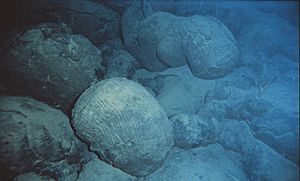
As you go deeper underwater, sunlight gets absorbed. This means less and less visible light reaches you. Water absorbs red light more than blue light. So, the colors change quickly as you go deeper. White objects look bluish underwater, and red objects look dark, almost black. In very clear ocean water, less than 25% of surface light reaches 10 meters (33 feet) deep. At 100 meters (330 feet), only about 0.5% of the surface light remains.
The euphotic depth is where light intensity drops to just 1% of the surface value. This depth changes depending on how clear the water is. In murky rivers, it might be only a few meters. In the open ocean, it can be up to 200 meters (660 feet). Below this depth, plants like phytoplankton can't get enough light to grow.
Temperature
The ocean has three main temperature layers: the surface layer, the thermocline, and the deep ocean. The surface layer's average temperature is about 17 °C (63 °F). About 90% of the ocean's water is in the deep ocean, below the thermocline. Most of this deep water is colder than 4 °C (39 °F).
However, there are hot spots near active volcanoes and hydrothermal vents. Here, deep-water temperatures can be much hotter than 100 °C (212 °F)!
Thermal Conductivity
Water conducts heat about 25 times better than air. This means your body loses heat much faster in water than in air. Hypothermia is a dangerous condition where your body's core temperature drops below 35 °C (95 °F). This is why divers wear diving suits to stay warm in water colder than 25 °C (77 °F).
Acoustic Properties
Sound travels about 4.3 times faster in water (1,484 meters per second in fresh water) than in air (343 meters per second). Our brains figure out where sounds come from by noticing tiny differences in when the sound reaches each ear. Because sound travels so fast in water, divers find it hard to tell where sounds are coming from underwater. Many animals have adapted to this and use sound to find their way around underwater.
Underwater Ecosystems
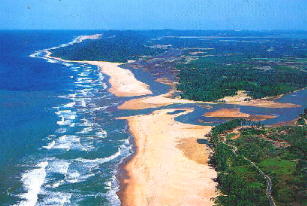
An aquatic ecosystem is a community of living things that depend on each other and their water environment. The two main types are marine ecosystems (salty water) and freshwater ecosystems.
Marine ecosystems are the largest on Earth. They have high salt content. Marine waters cover over 70% of Earth's surface. They hold more than 97% of Earth's water and 90% of the living space on Earth! Marine ecosystems include places like salt marshes, coral reefs, and the open ocean. They are home to at least 230,000 known species. But because so much of the ocean is unexplored, there could be over two million species!
Freshwater ecosystems include lakes, ponds, rivers, streams, springs, aquifers, and wetlands. They have less salt than marine ecosystems. Freshwater habitats can be still water (like lakes) or flowing water (like rivers).
In aquatic ecosystems, light is limited because water absorbs it. But nutrients are dissolved in the water, making them easy for plants to use. The amount of light and its colors change a lot with depth. This affects how plants and phytoplankton grow. Below the euphotic zone, there's no sunlight, so life must find other energy sources.
Humans and the Underwater World
Even though people do many things underwater, like research, diving, and using submarines, the underwater environment is tough for humans. It's still mostly unexplored.
One big problem for humans underwater is that our lungs don't work naturally there. Unlike fish, our lungs are made for breathing air at normal air pressure. To stay underwater for more than a few minutes, we need special equipment to help us breathe.
Our solid body parts, like bones and muscles, can handle the high pressure underwater. But gas-filled spaces, like our mouth, ears, and lungs, are a problem. Gas can be squeezed much more than liquids or solids. If the pressure inside these spaces isn't equal to the outside water pressure, it can cause pain. Your eardrum can even burst at depths of less than 3 meters (10 feet)! The danger of pressure damage is greatest in shallow water.
High pressure also affects the gases we breathe. Over time, this can lead to problems like inert gas narcosis (feeling dizzy) or oxygen toxicity (too much oxygen). After deep dives, divers must come up slowly. This is called decompression. It prevents bubbles from forming in their bodies, which can cause decompression sickness.
Also, the underwater environment usually cools the human body quickly. This can lead to hypothermia, which is very dangerous.
Hazards Underwater
There are several dangers for humans in the underwater environment:
- No breathable gas: This can cause drowning.
- High pressure: Can cause injuries called barotrauma or make breathing gases toxic.
- Cold temperatures: Can lead to hypothermia.
- Coming up too fast: Can cause decompression sickness.
- Strong water movement: Ocean currents and waves can push divers into things or to unsafe depths.
- Dangerous aquatic animals: Some sea creatures can be harmful.
Ambient Pressure Diving
In ambient pressure diving, the diver is directly exposed to the water's pressure. Divers might hold their breath, or use special breathing gear like scuba diving equipment or surface-supplied diving gear. For very long, deep dives, divers can use a technique called saturation diving. This helps reduce the risk of decompression sickness. Being in cold water and under high pressure affects the diver's body. This limits how deep and how long they can stay underwater. But new technologies help divers go deeper and stay longer.
Atmospheric Pressure Diving
A diver can stay at normal air pressure inside a special suit called an atmospheric diving suit (ADS). This suit looks like a small robot suit. It has special joints that let the diver move while keeping the inside pressure the same as on land. An ADS can be used for very deep dives, up to 700 meters (2,300 feet), for many hours. It removes most of the dangers of deep diving. The diver doesn't need to decompress or use special gas mixtures. They are also safe from most sea creatures. However, moving around and doing delicate tasks can be harder in an ADS.
Submersibles and Submarines
A submersible is a small vehicle made to work underwater. It's different from a submarine because a submarine can usually operate on its own for a long time. A submersible often needs support from a ship on the surface. There are many types of submersibles. Some have people inside, and others are robots called remotely operated vehicles (ROVs).
Remotely Operated or Autonomous Vehicles
Remotely operated underwater vehicles (ROVs) and autonomous underwater vehicles (AUVs) are types of underwater robots. ROVs are controlled by a crew from a ship or land. They are connected to the ship by a cable that sends power, video, and data. Most ROVs have a camera and lights. They can also have other tools to do different jobs.
Autonomous underwater vehicles (AUVs) are robots that travel underwater by themselves. They don't need a person to control them directly.
Sciences That Study Underwater Environments
- Hydrology – The study of water on Earth.
- Hydrography – The study and mapping of water bodies.
- Limnology – The study of inland waters like lakes and rivers.
- Marine biology – The study of living things in the ocean.
- Marine chemistry – The study of chemicals in the ocean.
- Marine ecology – The study of how ocean life interacts with its environment.
- Marine geology – The study of the ocean floor.
- Oceanography – The study of the ocean.
- Potamology – The study of rivers.
- Underwater archaeology – The study of human history underwater.
Images for kids
-
Notice the bluish color of objects in this underwater photo of pillow lava (NOAA).
See also
 In Spanish: Entorno subacuático para niños
In Spanish: Entorno subacuático para niños
- Timeline of diving technology
- Underwater acoustics
- Underwater photography
- Underwater vision
- Science of underwater diving
- UNESCO Convention on the Protection of the Underwater Cultural Heritage


